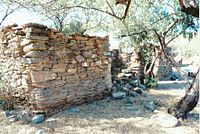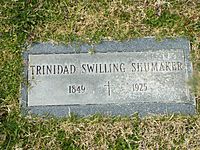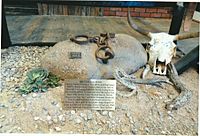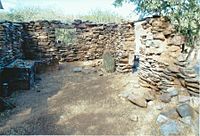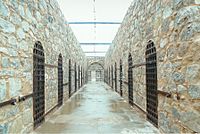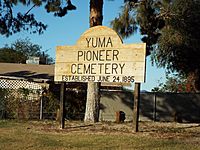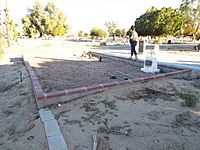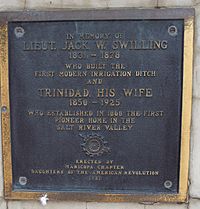Jack Swilling facts for kids
Quick facts for kids
Jack Swilling
|
|
|---|---|
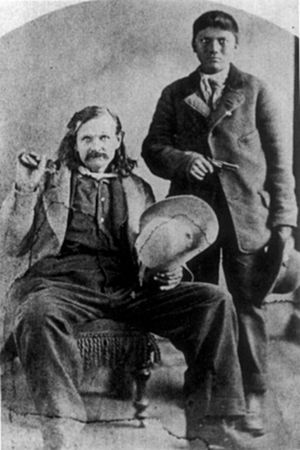
Jack Swilling with his Apache ward Guillermo Swilling, ca. 1875.
|
|
| Born | April 1, 1830 Anderson, South Carolina |
| Died | August 12, 1878 (aged 48) Yuma, Arizona Territory |
| Allegiance | |
| Service/ |
|
| Years of service | 1861–1862 |
| Rank | First Lieutenant |
| Unit | Arizona Guards |
| Battles/wars | |
John W. "Jack" Swilling (born April 1, 1830 – died August 12, 1878) was an important pioneer in the early days of Arizona Territory. Many people credit him as one of the main founders of the city of Phoenix. Swilling also helped open up the central Arizona highlands for new settlers. His discoveries led to a gold rush in the area. This gold rush then led to the creation of Arizona's first capital city, Prescott.
Jack Swilling served in the Confederate States Army as a local soldier. He also helped the United States Army as a civilian during the American Civil War. He worked in many different jobs throughout his life. He was a teamster (someone who drives wagons), a prospector (looking for gold), and a mine owner. He also owned saloons and dance halls. Later, he became a canal builder, farmer, rancher, and public servant. He did all this while facing health challenges from serious injuries he got in 1854.
Contents
Jack Swilling's Early Adventures
Growing Up and Moving West
John William "Jack" Swilling was born on April 1, 1830, in Anderson, South Carolina. He was one of ten children. When Jack was 14, his family moved to Georgia. Three years later, he and his older brother joined a group of Georgia volunteers. They served in the Mexican–American War. After the war, they returned home.
In 1852, Jack married Mary Jane Gray in Wetumpka, Alabama. Their daughter, Elizabeth, was born a year later. In 1854, Jack suffered serious injuries, including a broken skull. These injuries affected him for the rest of his life. In 1856, he left for the American West. He joined a wagon train as a teamster in 1857. This slow-moving group arrived in Mesilla in 1858. Mesilla was then part of the New Mexico Territory.
After arriving in Arizona in 1858, Swilling moved to southern California. There, he joined a gold rush near Los Angeles. A few months later, he returned to Arizona. He was drawn back by the gold rush at Gila City. He also worked for the Butterfield Overland Mail Company there.
Protecting Settlers and War Service
Swilling was chosen to be the captain of the Gila Rangers. This was a local group formed to protect miners from Apache raids. In January 1860, the Gila Rangers explored the Bradshaw Mountains in central Arizona. They were looking for Apache raiders. During this trip, they found the Hassayampa River. They also found signs of gold and other minerals. The area seemed good for ranching and farming. However, it was too far away and dangerous for settlers at that time.
Soon, the gold in Gila City ran out. Swilling then followed his friend, Colonel Jacob Snively, to Pinos Altos. There, he mined for gold and ran a saloon. When the Union Army left the New Mexico Territory at the start of the American Civil War, the men of Pinos Altos formed a group called the Arizona Guards. This group was for defense against Apache attacks. In 1861, Confederate Arizona officially separated from the Union. Swilling was elected as the second-in-command, or First Lieutenant. He kept this rank when the Arizona Guards joined the Confederate Army. Swilling likely fought in the Battle of Pinos Altos, a Confederate victory.
After defending against Apaches, Swilling led some of the Arizona Guards to Tucson in 1862. He is thought to have led a group that burned Stanwix Station. They also had a small fight with the Union Army's California Column there. He was also involved in an event at White's Mill where Union Captain James McCleave was captured.
After the Union Army took over Tucson in May 1862, Swilling's company retreated. He then became a civilian worker for the United States Army. He first delivered messages between generals. Later, he became a scout in a campaign against the Apaches. He was involved in the effort to take Mesilla, which ended with the Union taking over the Confederate capital. During this time, he met the Walker Party. Swilling helped capture the famous Apache chief Mangas Coloradas.
New Gold Discoveries and Family Life
Swilling's war service ended there. He convinced Joseph Walker and his group that there was gold in the central highlands of the new Arizona Territory. He then guided them to the area where the first Yavapai County mining district was formed. This was near present-day Prescott, on May 10, 1863. They called it the Pioneer Mining District. The rules they made there were the area's first recorded laws.
Swilling left the Walker party soon after. He joined another group led by Pauline Weaver and Abraham Harlow Peeples. He made a good amount of money from a unique gold mine at Rich Hill. This was located between Wickenburg and Prescott. News of his success spread. Two gold samples from Swilling's claim were even sent to President Abraham Lincoln.
Next, Swilling briefly owned part of a flour mill in Tucson. He soon grew tired of Tucson and returned to Yavapai County. There, he prospected for gold, owned gold mines, and farmed. He also delivered mail between Prescott and the Pima villages. During all this activity, Jack Swilling married a young woman named Trinidad Mejia Escalante (1847–1925). They were married on April 11, 1864, in Tucson. Trinidad was about seventeen. Over the next fourteen years, they had seven children. They also adopted two Apache orphans.
Founding Phoenix and Later Years
Building Canals and a New Community
Jack Swilling had an idea to create a canal company. This company would open the Salt River Valley for farming. On November 16, 1867, he formed the Swilling Irrigating and Canal Company. Soon after, Swilling and a small group of men began building the first modern irrigation canals in the Salt River Valley. Other pioneers had seen old Hohokam canals in the area. But it was Swilling who organized the first successful modern irrigation project. The next summer, they harvested their first crops of wheat, barley, and corn. He promoted this irrigation system, which was partly inspired by the ancient Hohokam canals.
The Swilling Irrigating and Canal Company started the small farming community of Phoenix. This community has since grown into one of the largest cities in the United States. Swilling claimed land for his own farm. He built a large home there. His farm was a local showplace. It had an artificial pond with tame ducks, a vineyard, and an orchard with many fruit trees.
In the early days, Jack Swilling was a very important leader in the Phoenix settlement. The first post office was set up in Swilling's home on June 15, 1868. Swilling served as the postmaster. He was also the first justice of the peace. He helped plan and build more canals. This included the first ditch south of the Salt River. He partnered with Charles T. Hayden, who founded Tempe, Arizona.
Final Years and Legacy
Once Phoenix was well-established, Swilling lost interest. He moved his growing family back to central Arizona. There, he mined, farmed, and ranched.
By the spring of 1878, he and his family lived in Gillett. His health was getting worse. His wife, Trinidad, suggested he take a trip to find and rebury their old friend, Colonel Jacob Snively. Snively had been killed by Apaches. While Swilling was on this trip, three masked men robbed a stagecoach near Wickenburg. The description of the robbers matched Swilling and his companions. They became suspects in the robbery.
Jack Swilling and Andrew Kirby were arrested. They were taken to a federal jail in Yuma. The conditions inside the jail were very poor. This made Jack Swilling's health much worse. He was released to friends, the Hodges family, and died in their home. The real robbers were identified only after Swilling's death, proving his innocence too late.
Jack Swilling's Burial and Memorial
According to his wife, Trinidad Swilling, Jack died at the Hodges family home in Yuma. The Hodges family owned burial plots in the Yuma Pioneer Cemetery. Swilling was buried there before his family could be told. His headstone was missing for a long time but has since been replaced.
After his death, some people started to spread stories about Swilling being a "badman." However, friends remembered Jack Swilling as an honest, hard-working, and generous man. He was always ready to help others who needed food or a place to stay. He was known to risk his own life to help people during Apache attacks.
On February 19, 1931, a special ceremony took place in Phoenix. The Daughters of the American Revolution, along with Arizona Governor George W. P. Hunt, dedicated a fountain to Jack and Trinidad Swilling. The fountain stands in the park in front of the courthouse building. It has a small bronze plaque that reads: "In memory of Lieut. Jack W. Swilling, 1831–1878, who built the first modern irrigation ditch, and Trinidad, his wife, 1850–1925, who established in 1868 the first pioneer home in the Salt River Valley."
See also
- Phoenix, Arizona
- List of historic properties in Black Canyon City, Arizona


